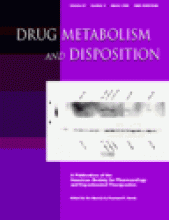Abstract
A marked difference in hepatic activity of aldehyde oxidase between rats and monkeys was found to be responsible for the previously reported marked species difference in the metabolism of Zaleplon in vivo. In the postmitochondrial fractions,S-9s, from liver homogenates of these animals, Zaleplon was transformed in the presence of NADPH into the side chain oxidation product, N-desethyl-Zaleplon, and the aromatic ring oxidation product, 5-oxo-Zaleplon. In the rat S-9,N-desethyl-Zaleplon and 5-oxo-Zaleplon were a major and a very minor metabolites, respectively. However, in the monkeyS-9, Zaleplon was transformed into 5-oxo-Zaleplon at a much higher rate than that for N-desethyl-Zaleplon formation. N-Desethyl-Zaleplon was formed in the monkeyS-9 at a rate almost equal to that in the ratS-9. N-Desethyl-5-oxo-Zaleplon was formed at a minor rate only in the monkey S-9 through N-desethyl-Zaleplon as an obligatory intermediate. The hepatic activity for the formation of 5-oxo-Zaleplon in the monkey and rat was localized in cytosol and did not require NADPH. Sensitivity to various inhibitors and requirement of water as oxygen source, using H218O, strongly suggested that the hepatic cytosolic formation of 5-oxo-Zaleplon was mediated by aldehyde oxidase.N-Desethyl-Zaleplon was formed in the presence of NADPH by microsomes from the liver of rats and monkeys, and its formation was strongly suggested using various cytochrome P-450 inhibitors to be mediated by a number of cytochrome P-450 isoforms, such as 3A, 2C, and 2D subfamilies.
Footnotes
-
Send reprint requests to: Kosuke Kawashima, Department of Pharmacokinetics, Medical Research Laboratories, Lederle (Japan), Ltd., 1–6-34 Kashiwacho, Shikishi, Saitama 353-8511, Japan. E-mail:kosuke_k{at}kt.rim.or.jp
- Abbreviations used are::
- AO
- aldehyde oxidase
- XD
- xanthine dehydrogenase
- XO
- xanthine oxidase
- Received September 11, 1998.
- Accepted December 15, 1998.
- The American Society for Pharmacology and Experimental Therapeutics
DMD articles become freely available 12 months after publication, and remain freely available for 5 years.Non-open access articles that fall outside this five year window are available only to institutional subscribers and current ASPET members, or through the article purchase feature at the bottom of the page.
|






